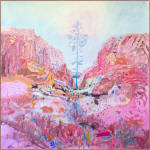Jo Bertini
A longing that never abates that amounts to a kind of love. Just like a tree searching into the earth for water. The desert rivers and creeks may only flow for short periods of time after rain but there’s usually a depth of water beneath the sand. Rains that fall here can become underground reservoirs, artesian basins, subterranean creeks and rivers. These stored waters can be over a million years old and are essential, ancient life sources that when flooded reappear on the surface of the desert, bringing up buried secrets. Permanent pools or waterholes are the most biologically significant places. If there is a tree or even microscopic plant in a seemingly harsh desert environment, it is a sentinel of hope, a sign of water. Natural springs, wadis and pools are the surface manifestation of the artesian basin. Water seeps to the surface through fractures and vents in the land. There are many species only endemic to particular desert springs with numerous rare or relic micro flora and fauna restricted to a single spring. Life in these places comprise long periods of suspended animation followed by bursts of accelerated growth and activity. Seeds and eggs can survive hundreds and thousands of years in the dry sands or baked mud until the next rains fill the creeks again.
Indigenous people have a long history of care-taking these places, knowing their sacred significance, traversing the desert using their knowledge of these waters. Since colonial settlement bores have been sunk, resulting in much reduced aquifer pressure and many ancient water extinctions. We too must value land as sacred and not see it merely as an interminable resource. We must value the ‘boom and bust’ cycles, times of stasis and torpor, suspended animation as an offered refuges of peaceWater moving from the heart of the earth, up through cracks and fissures, up the wild mountains and dunes is the same water that moves through our bodies.



